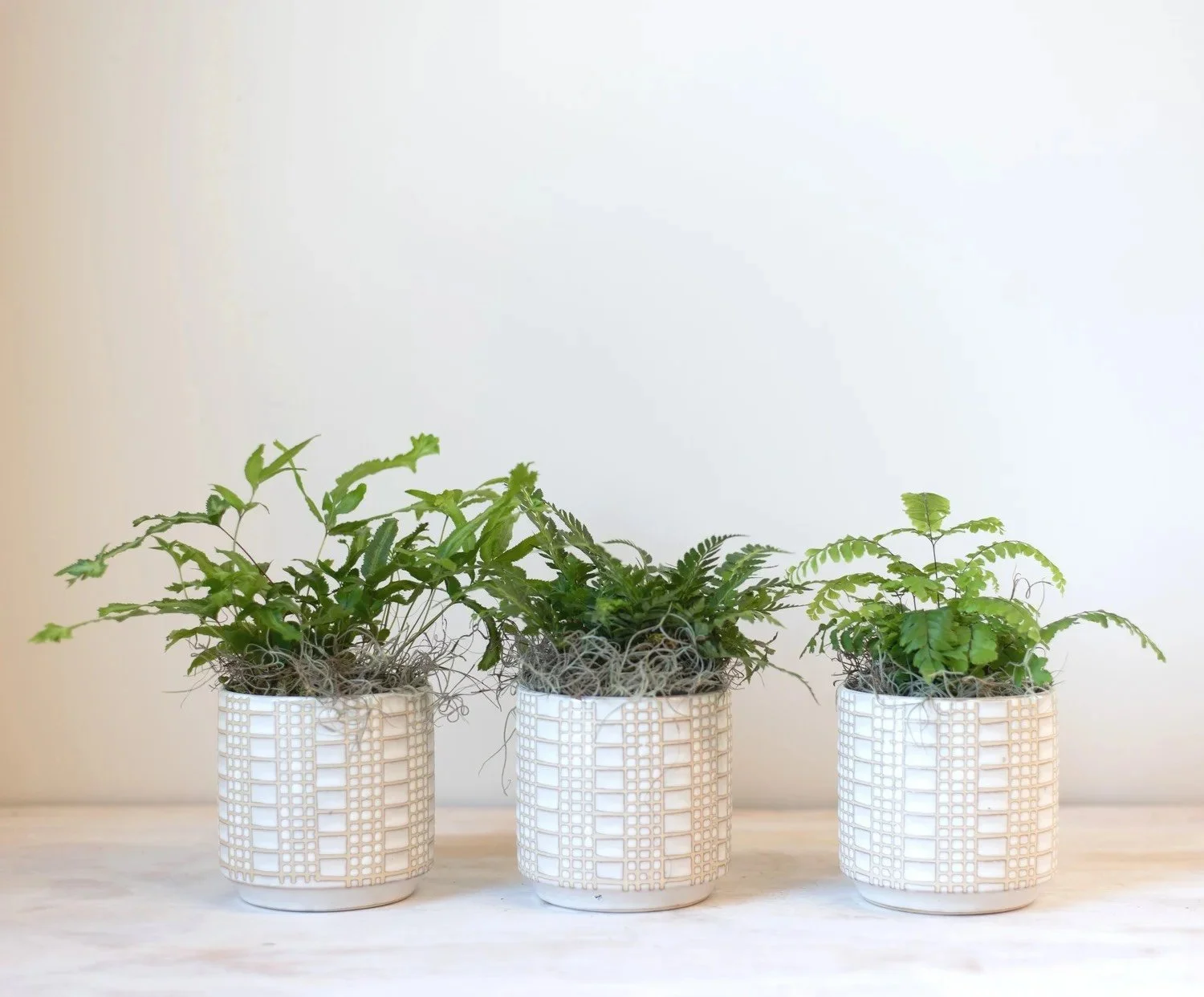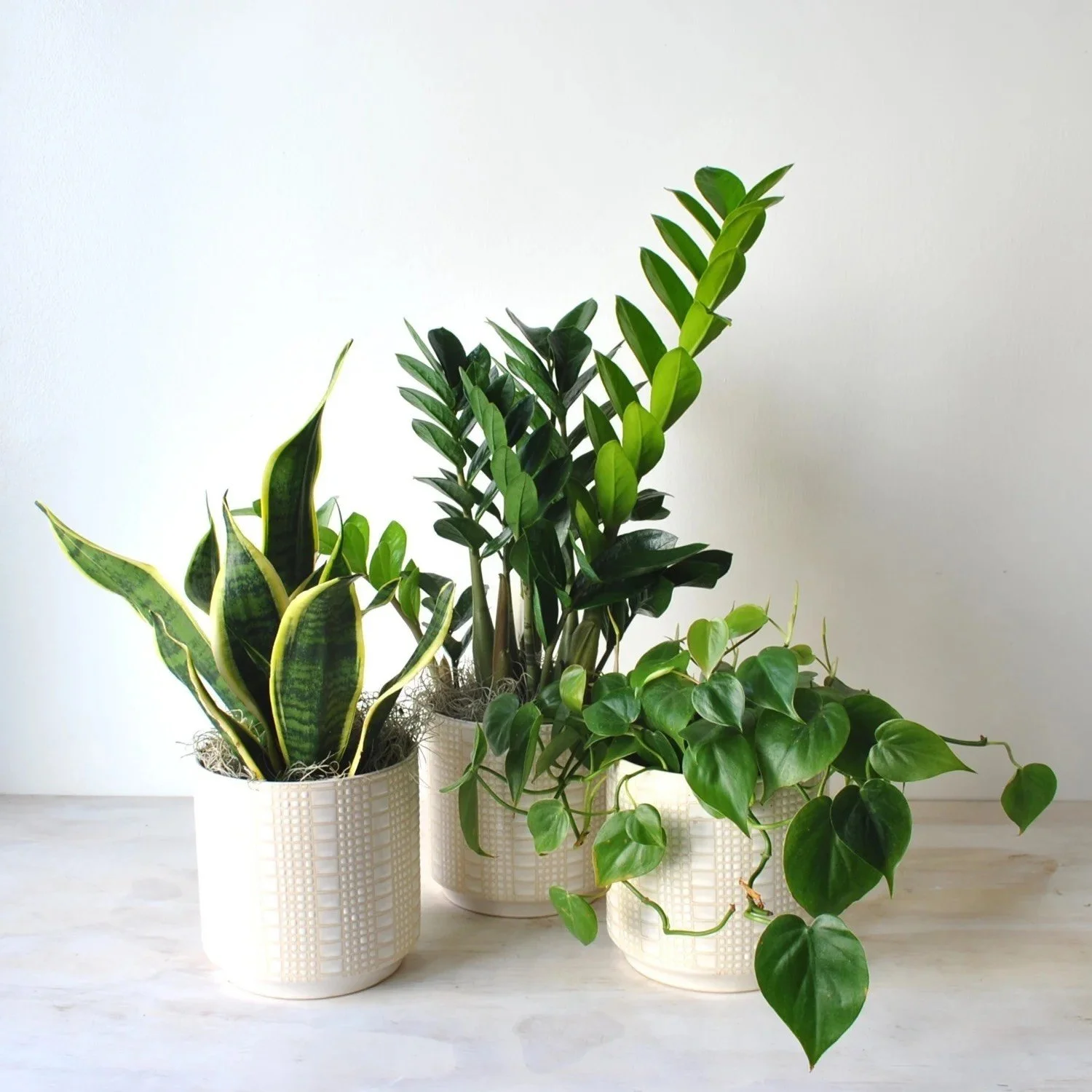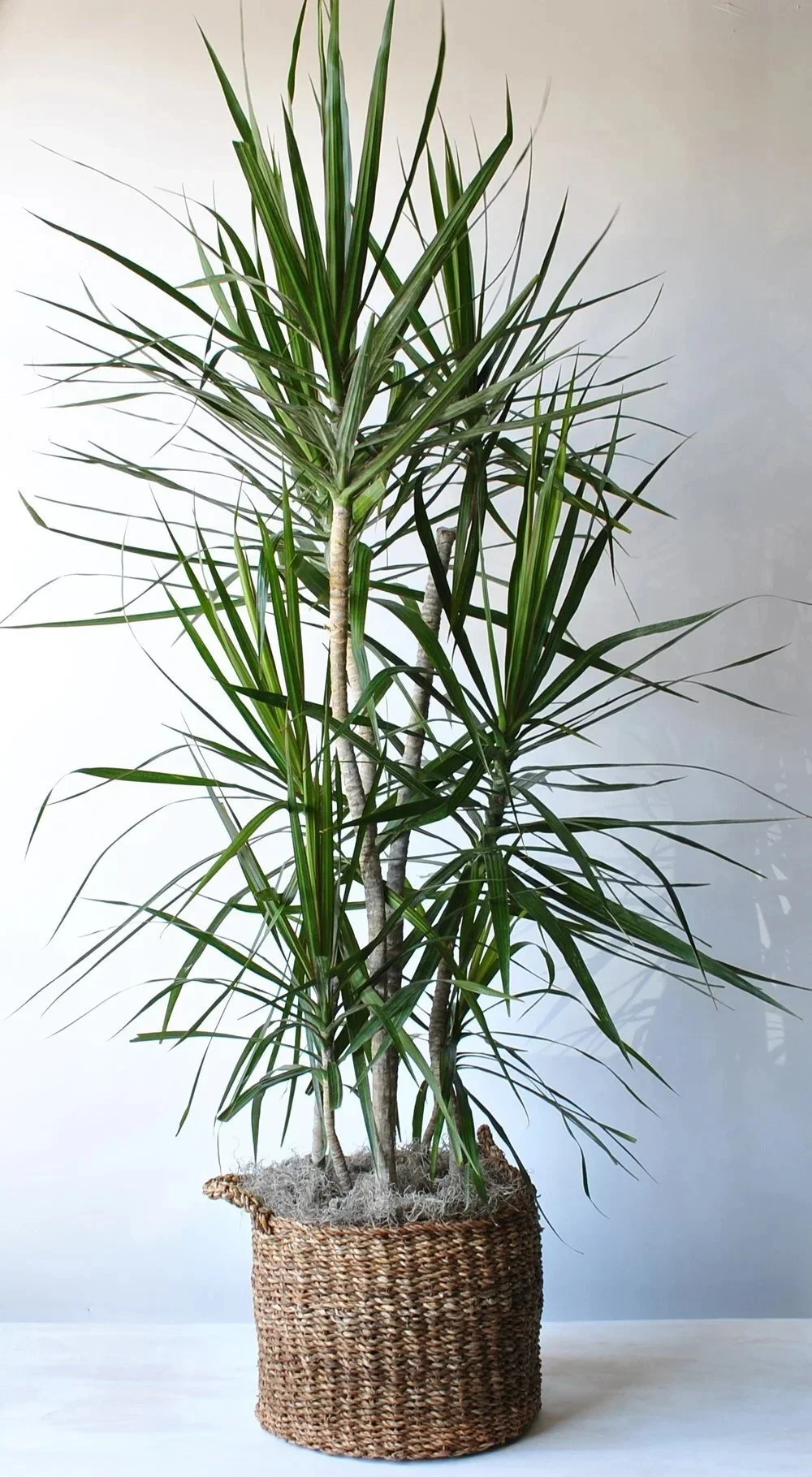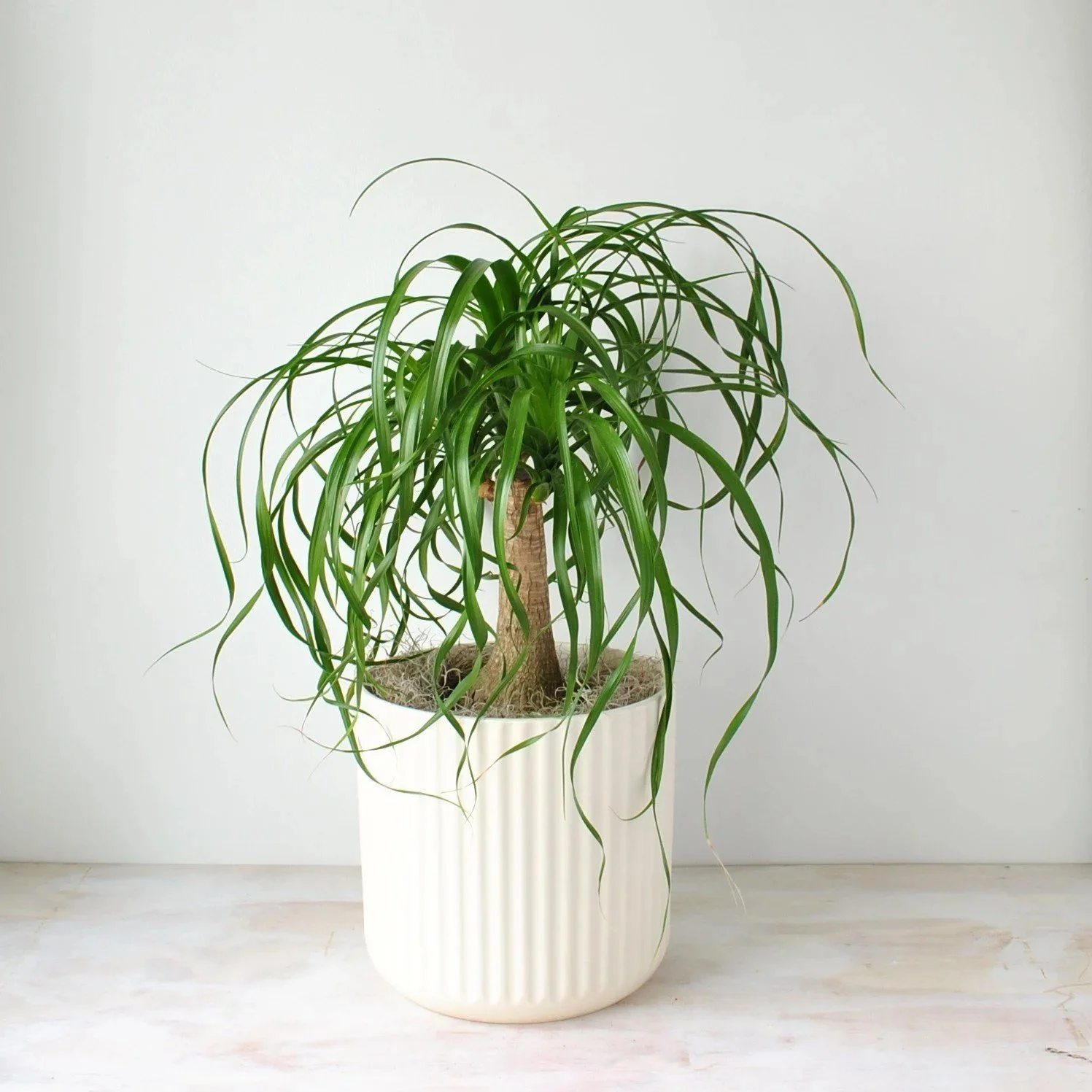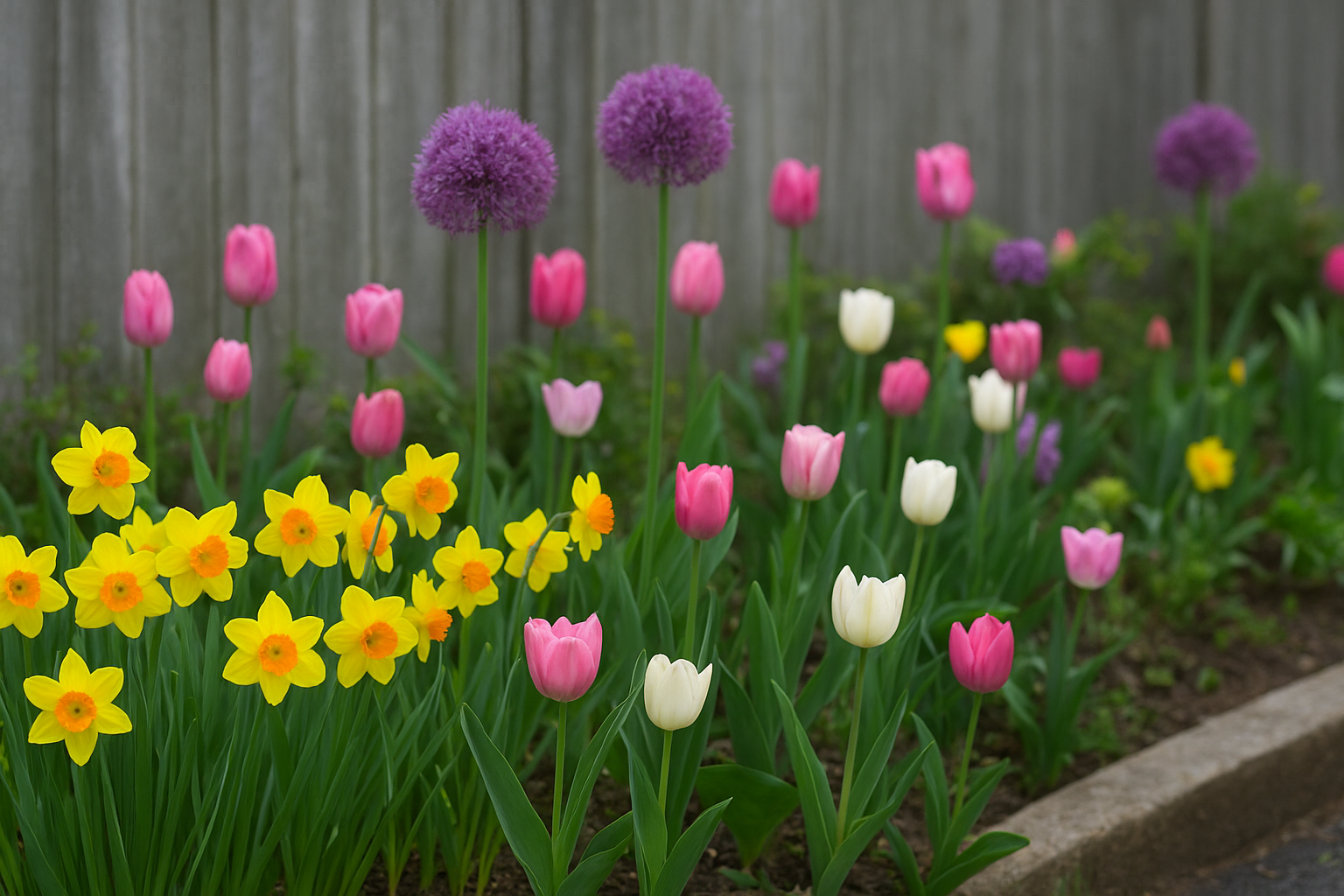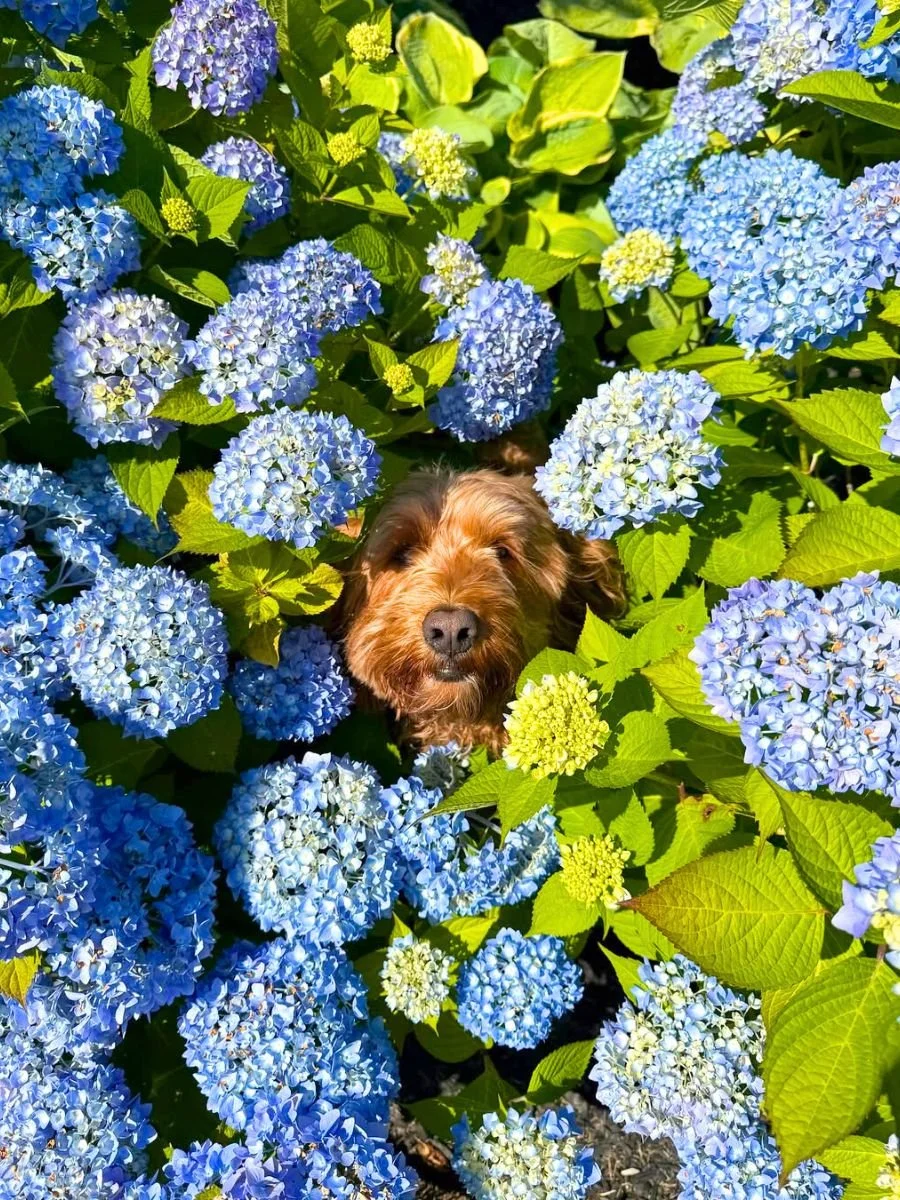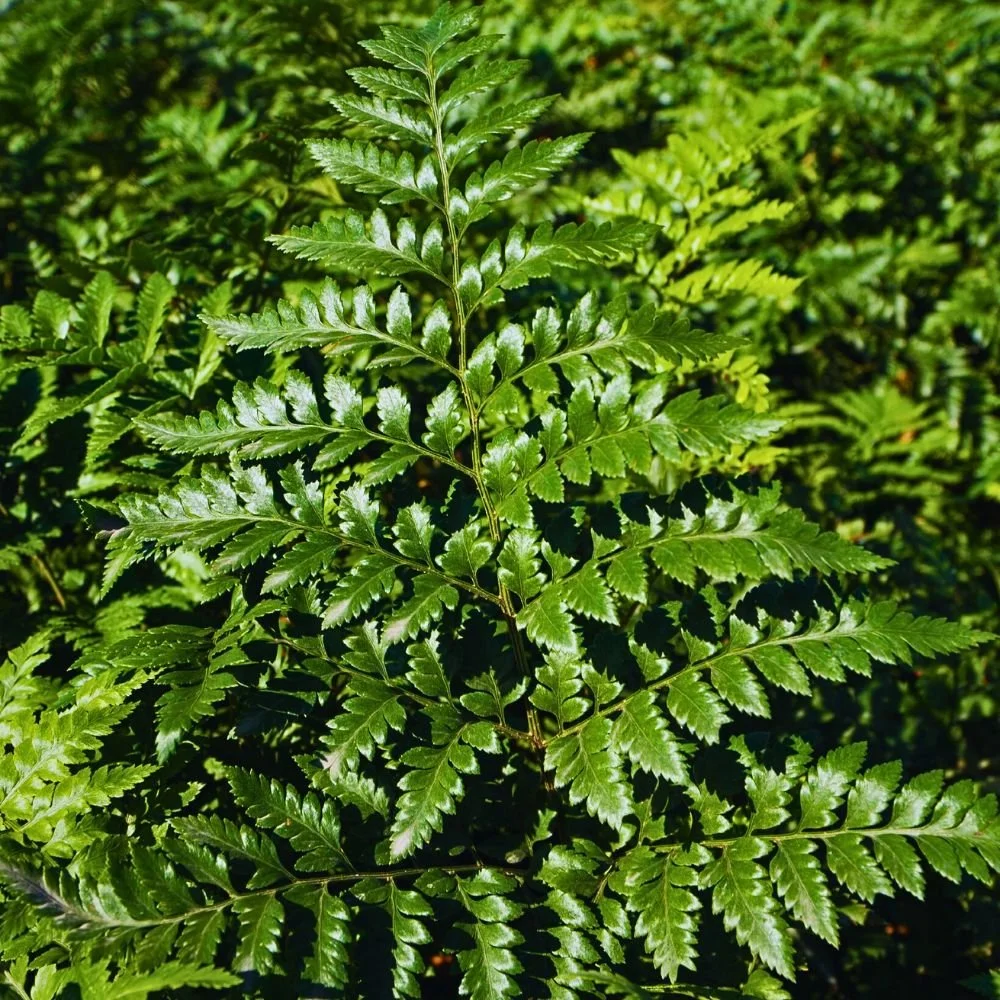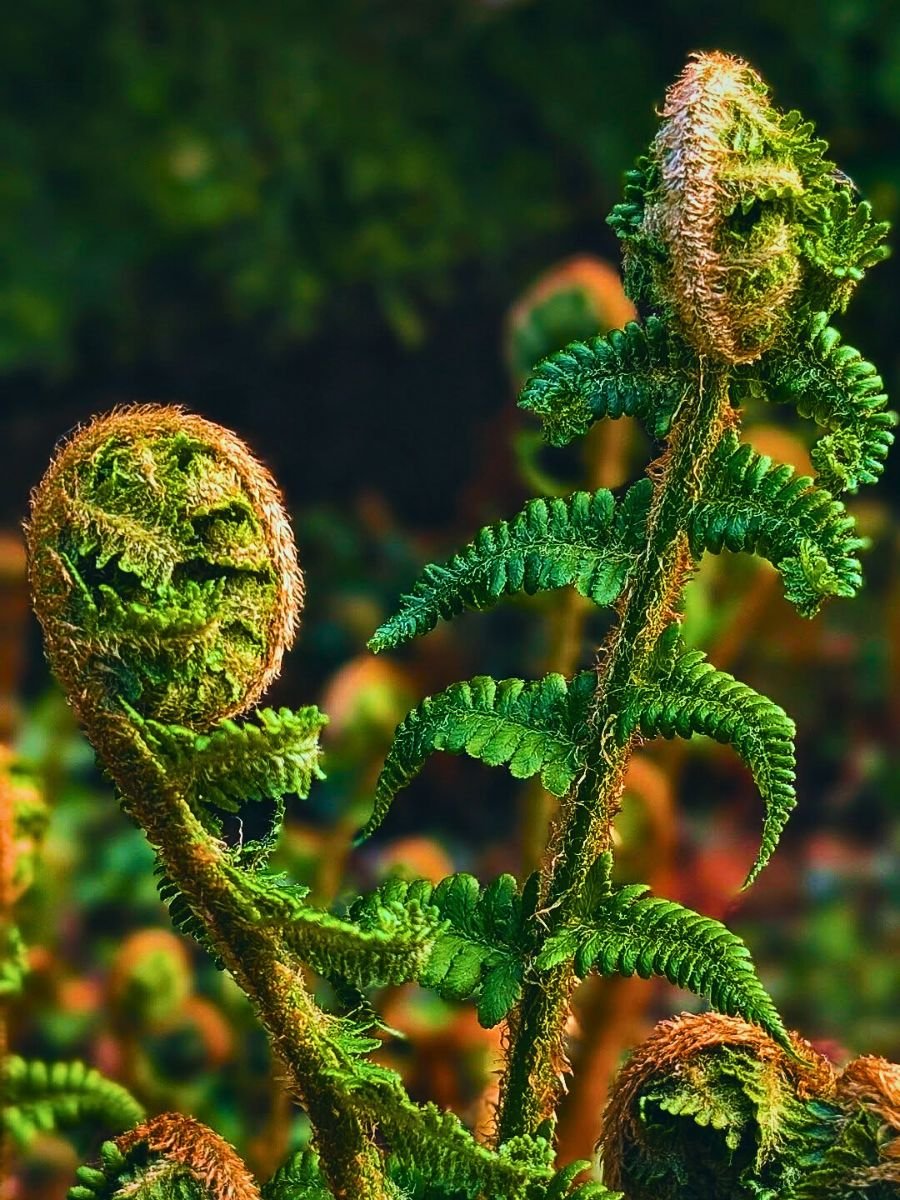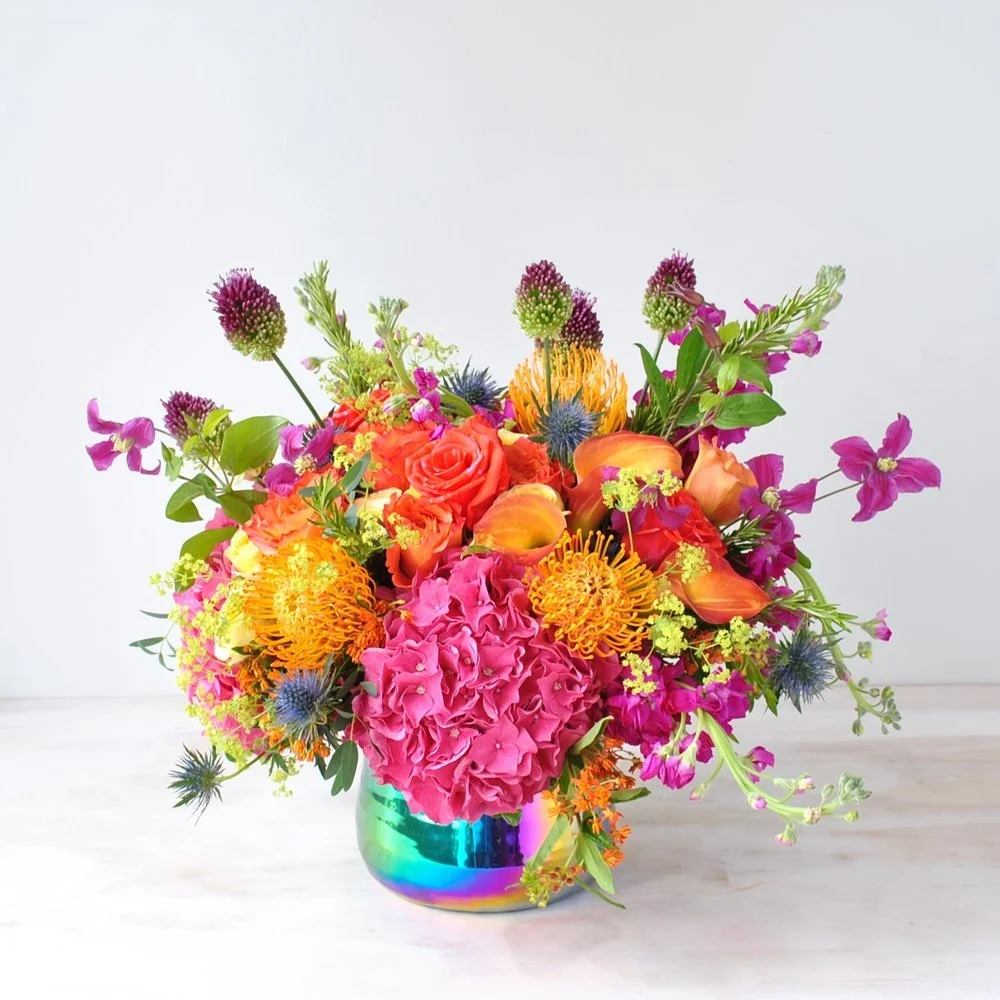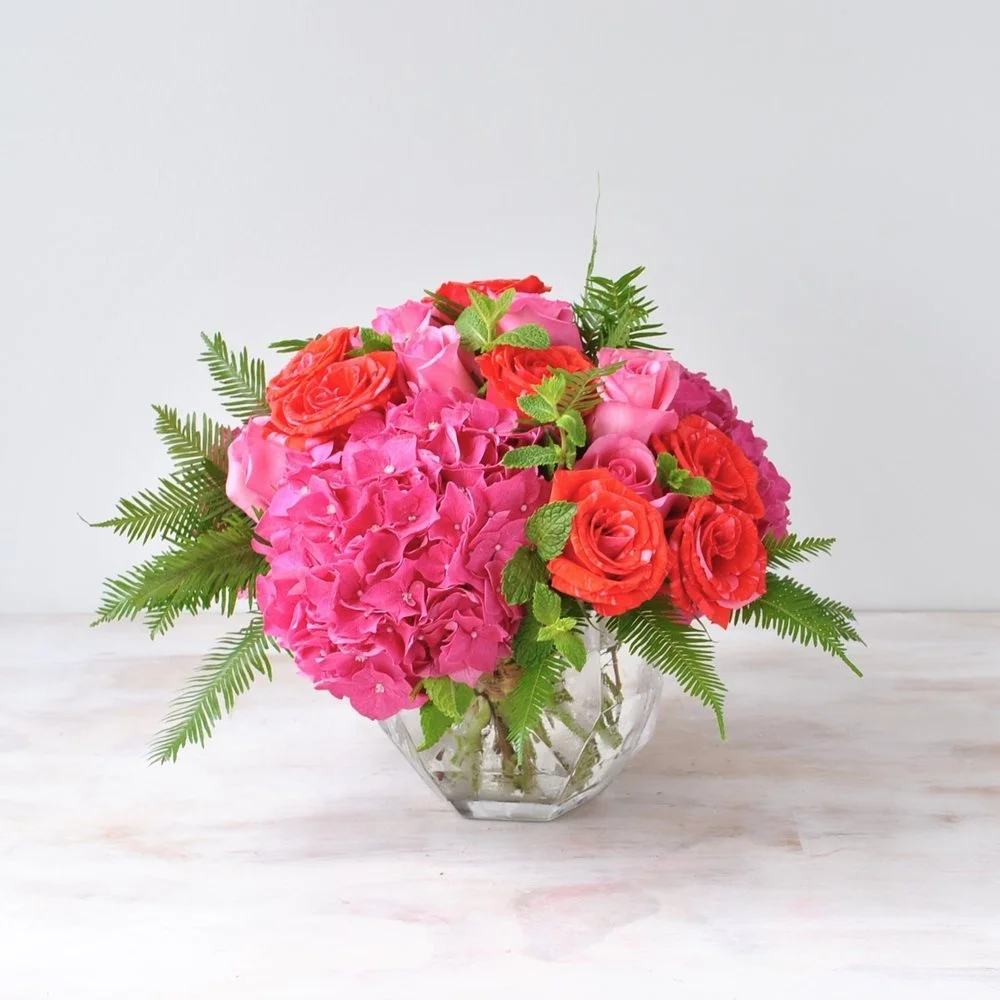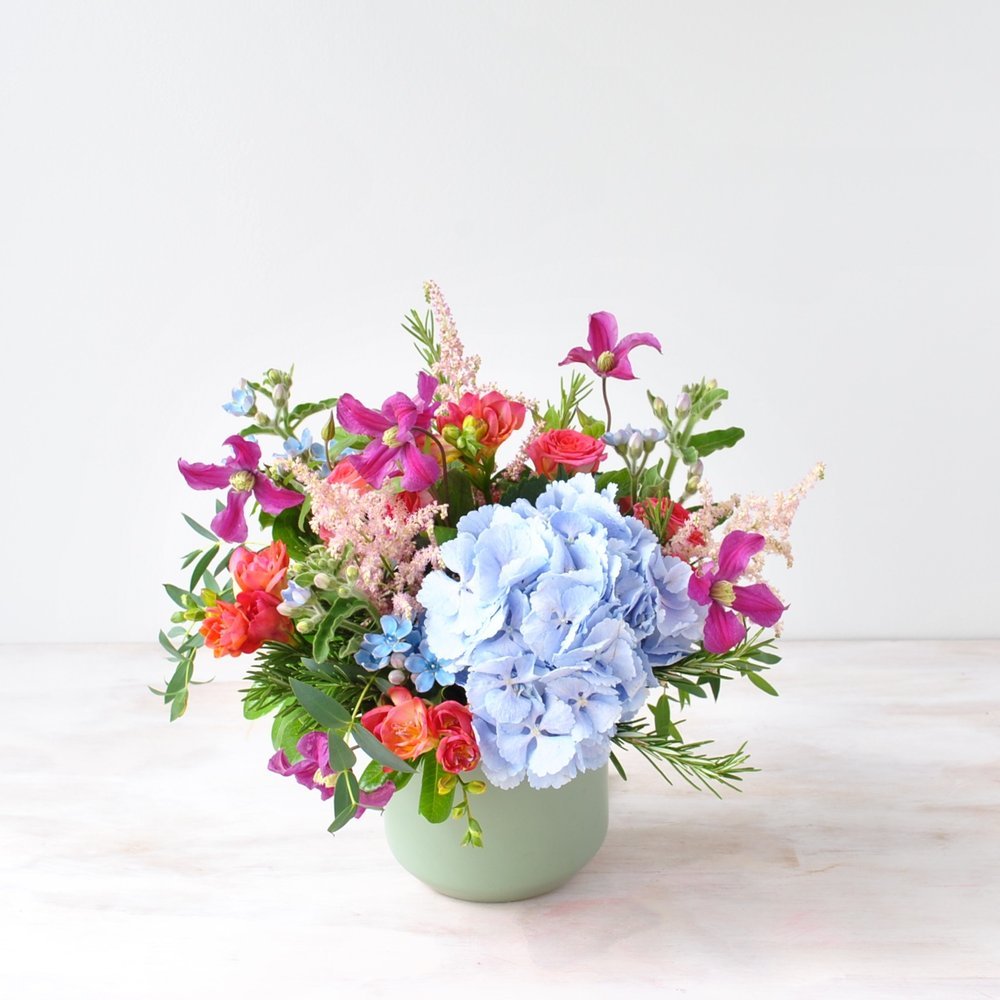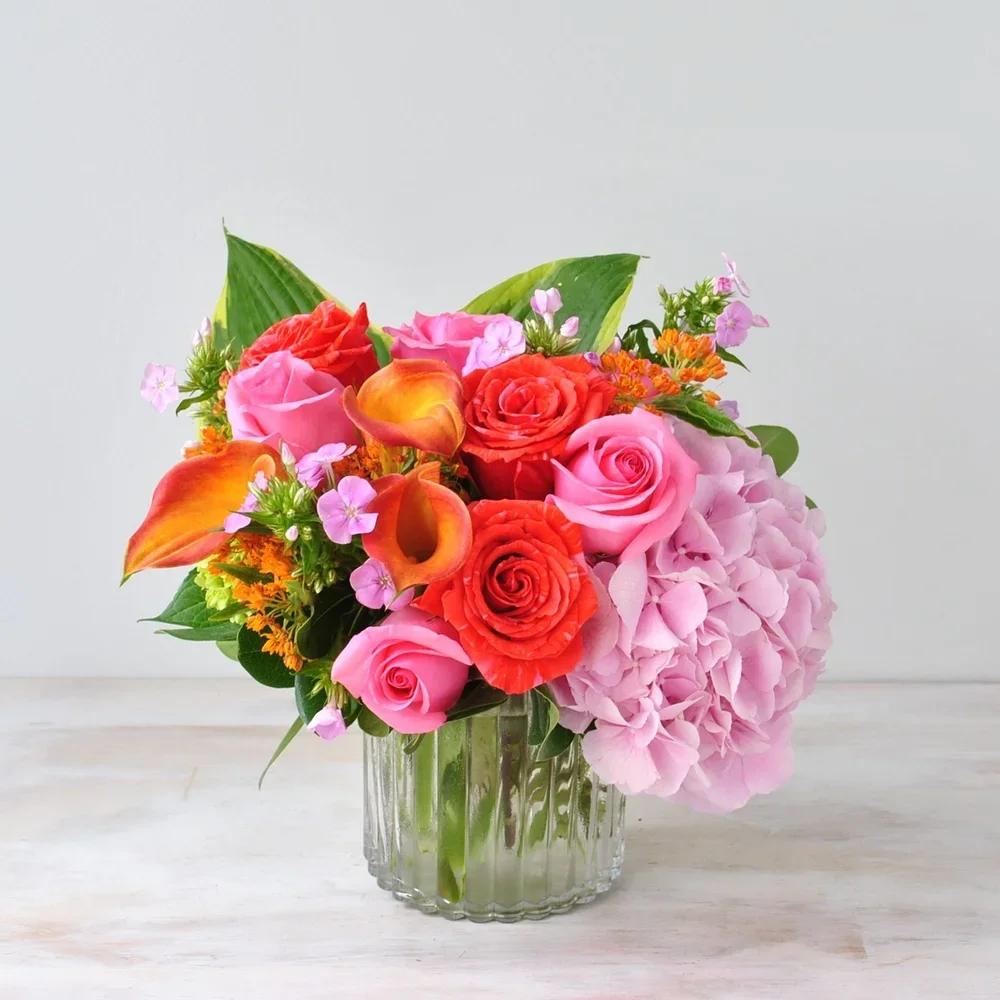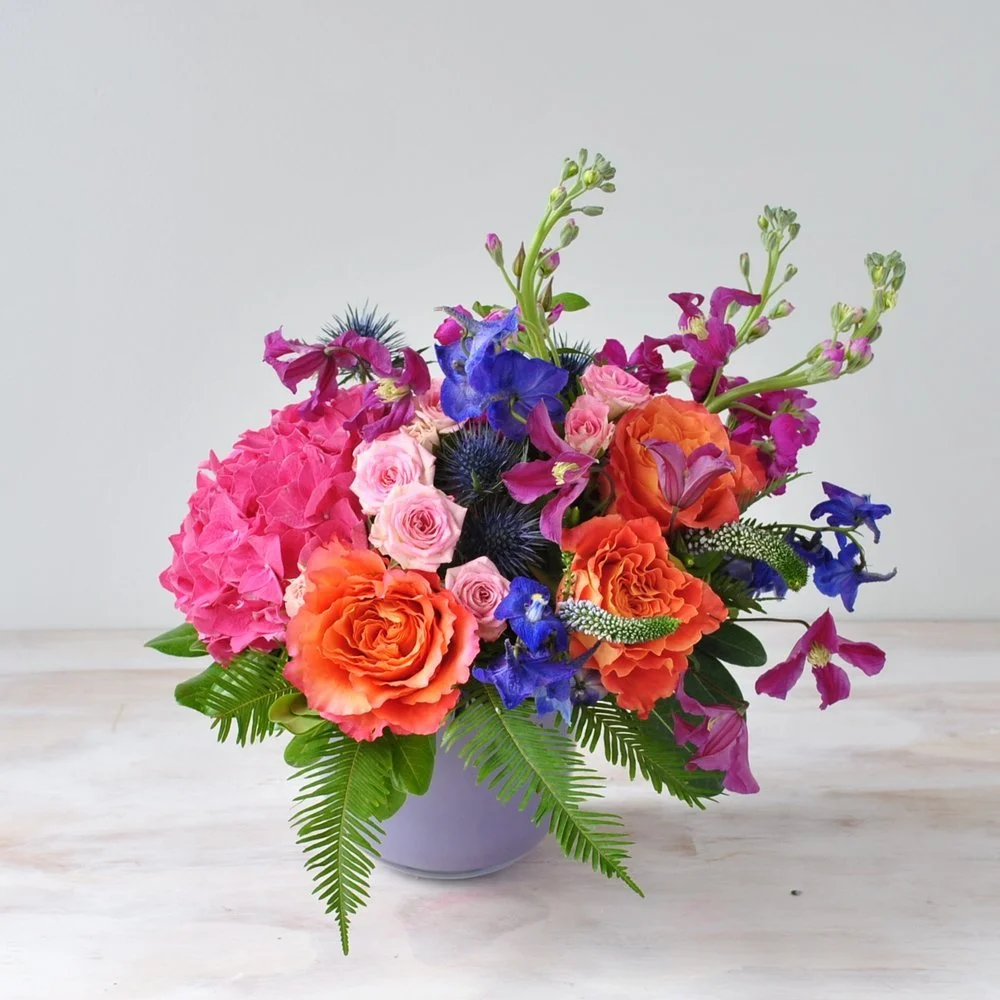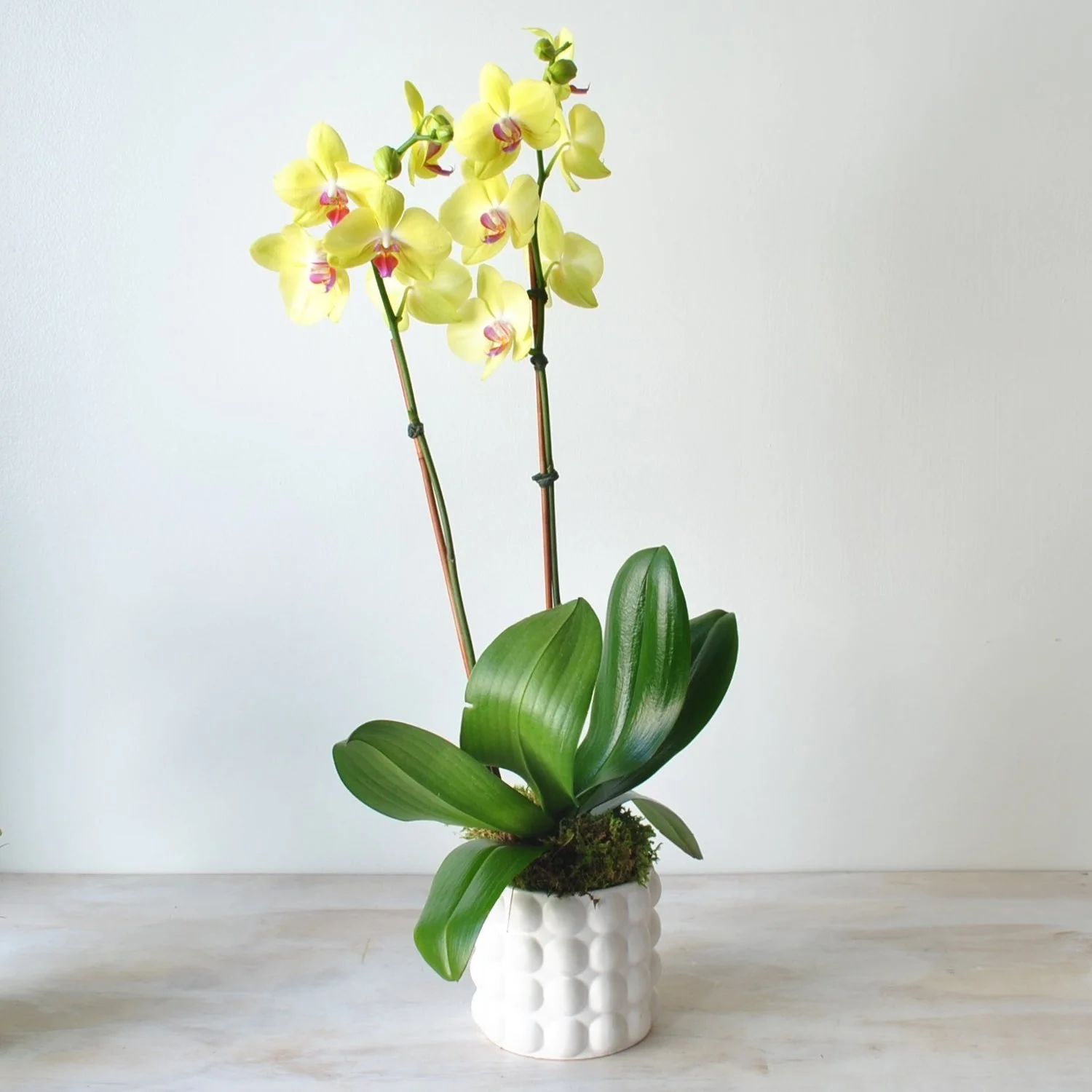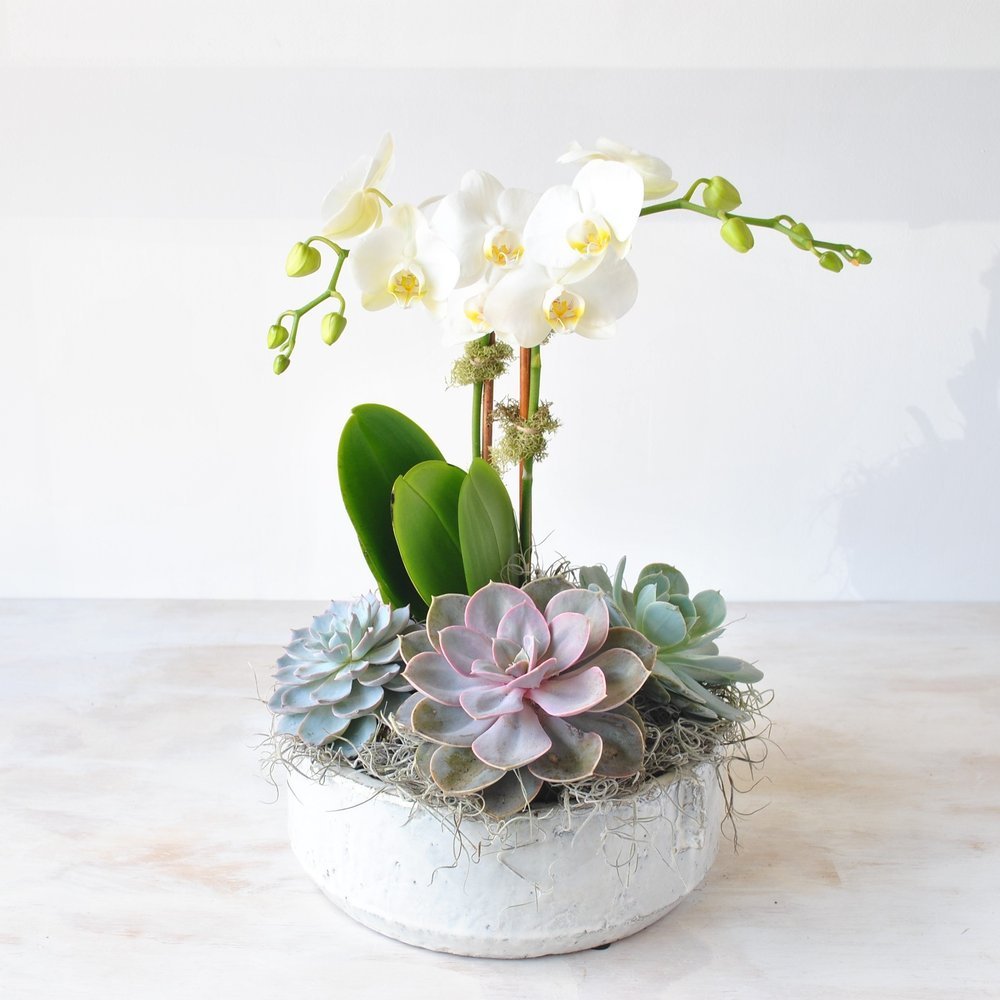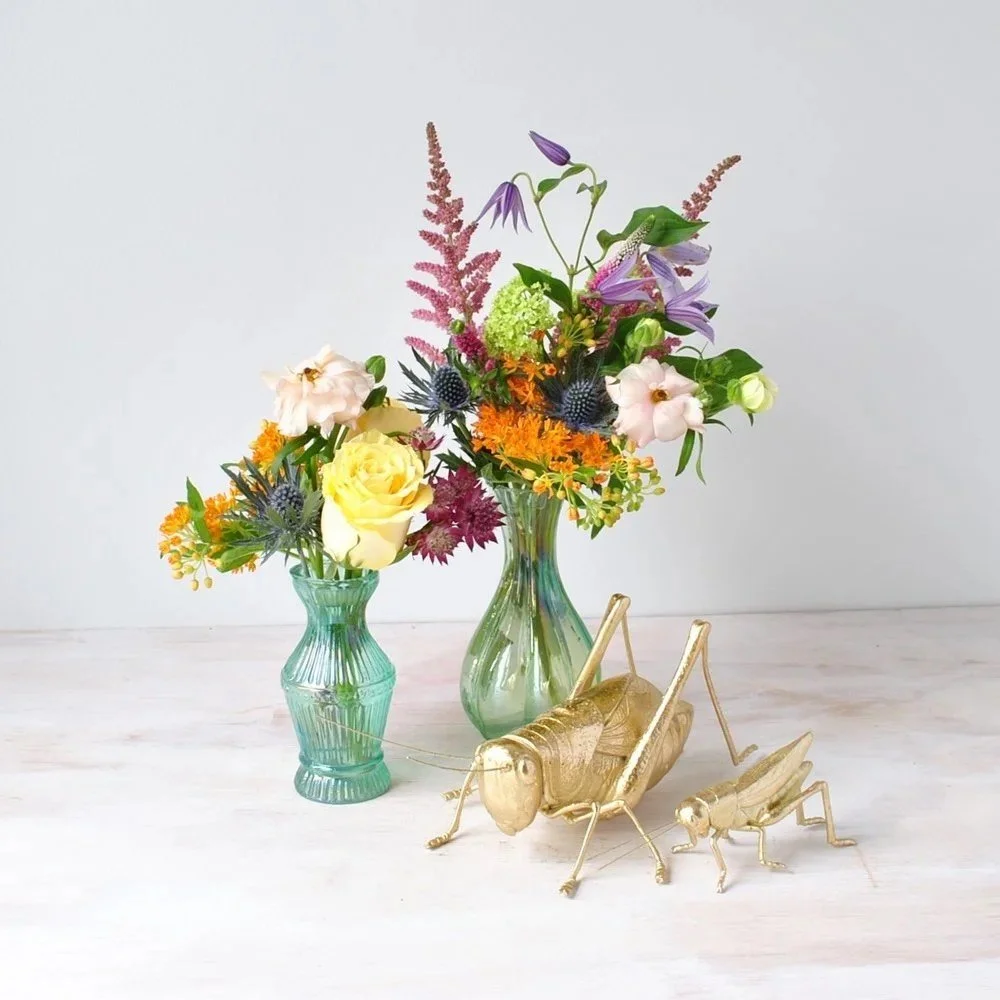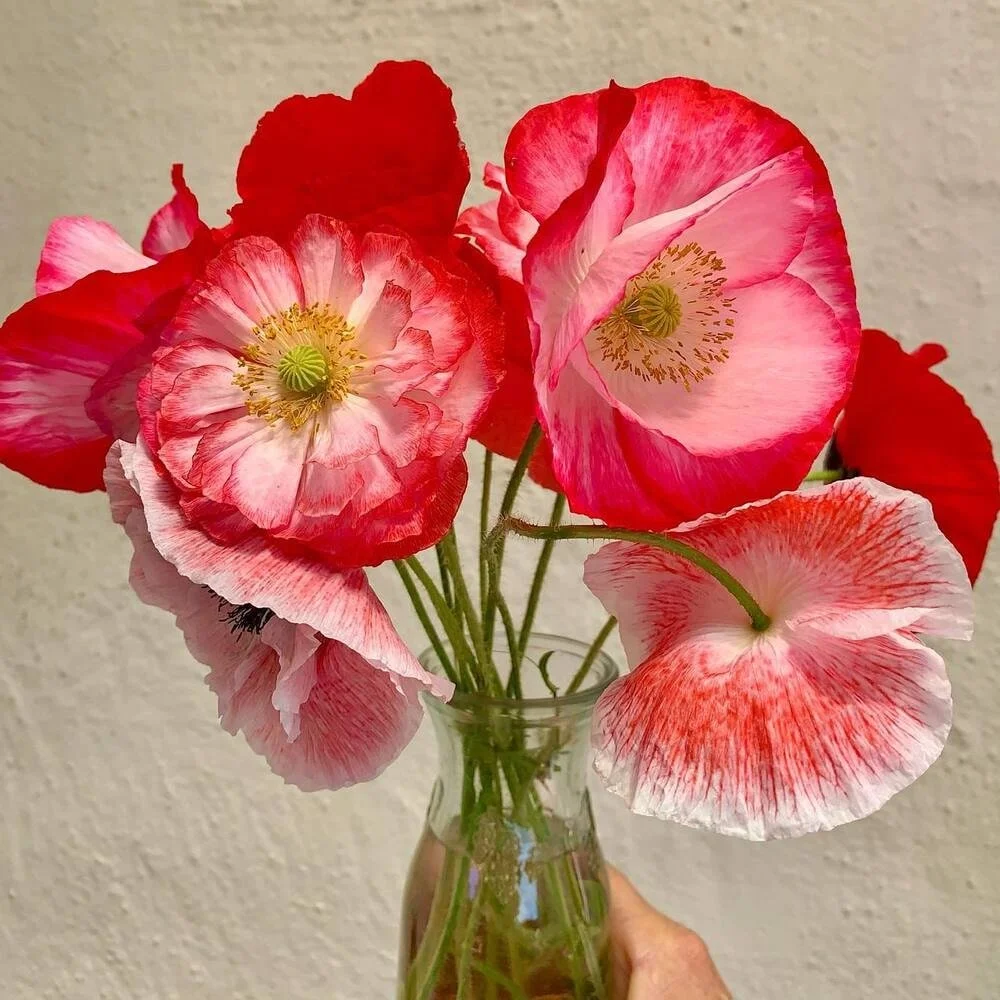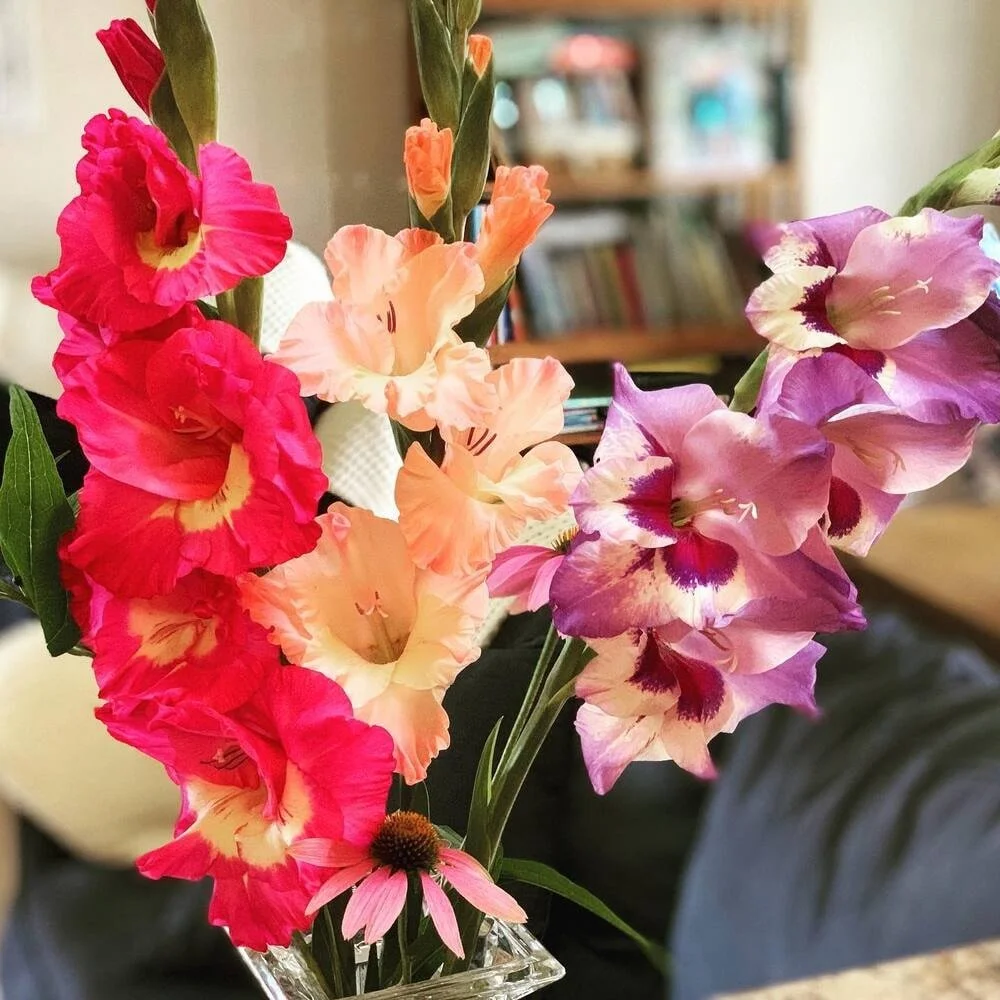Looking for fall gardening services in Boston? Rouvalis Flowers and Gardens offers seasonal window boxes, festive containers, bulb plantings, and expert maintenance to keep your home stunning all autumn.
Back to School Plant Refresh!
CommentWith the school year officially started what better way to spruce up your space than with beautiful house plants?
Shop online and in store with promo code “storrowed” to save 10% off all house plants!
Tabletop Plants
Perfectly sized for desks, end tables, coffee tables & window sills
Floor Plants
Statement sized to fill a corner or add a pop of color.
Shop in store with us
Beacon Hill & Winchester
Monday-Saturday: 10am-6pm
Adorn your space with fresh plants! 🪴
CommentMoving can be hard, leave it up to us to deliver your fresh new house plants... don't get storrowed! From lush plants, succulents, cacti, flowering orchids and home decor we have many options for new homes, apartments & dorms or a refresh after a summer away! Shop online and save 10% on all house plants and home decor using promo code "storrowed".
Tabletop Plants
Perfectly sized for desks, end tables, coffee tables & window sills
Floor Plants
Statement sized to fill a corner or add a pop of color.
Home Decor
Perfect to gift to anyone with a new space to fill
Holiday Weekend:
Closed 8/30-9/1
Beacon Hill & Winchester open 9/2 with regular hours
The Best Air-Purifying Plants to Give Your Home a Breath of Fresh Air Year After Year
CommentWhether your moving into a new home, apartment or dorm, house plants make a huge difference in air quality. Enjoy this read from Thursd.! on the top air-purifying plants!
Want to improve your home's air quality and boost your mood and productivity at the same time? These plants will do just that!
By: THURSD. | 20-08-2025 | 15 min read
Are you often concerned about your home's indoor air quality as pollution and CO₂ levels increase? Air-purifying plants are a great solution that not only removes toxins but also enhances the atmosphere of your room. You've probably heard before that plants have a great ability to keep the air fresh and clean. However, some houseplants offer additional air-purifying benefits, making them a popular choice for homes and offices.
Even better, houseplant grower collective, Air So Pure—just as their very name implies—supplies a wide range of these air-purifying houseplants, making them easily available. Just so you know, in 1989, NASA conducted a study on plants and discovered that they can absorb harmful toxins from the air, especially in enclosed spaces with little airflow. This study has been the basis for newer studies throughout the years on indoor plants and their air-purifying abilities.
The Best Air-Purifying Plants
Around the early 2000s, indoor plants that clean the air became a thing, and their popularity hasn't quite decreased ever since. Still, yet, they are especially popular now, seeing as many people nowadays spend more of their time indoors than before. Many work from home offices right within their houses. If you, therefore, want to improve your home's air quality and let plants help boost your mood and productivity at the same time, here are some of the best air-purifying plants that will do just that.
Golden Pothos (Epipremnum aureum)
Calathea makoyana
Nerve Plant (Fittonia albivenis)
English Ivy (Hedera helix)
Dumb Cane (Dieffenbachia)
Money Tree (Pachira aquatica)
Bamboo Palm (Chamaedorea seifrizii)
Snake Plant (Dracaena trifasciata)
Rubber Plant (Ficus elastica)
Boston Fern (Nephrolepis exaltata)
Fiddle-Leaf Fig (Ficus lyrata)
Dragon Tree (Dracaena marginata)
Parlor Palm (Chamaedorea elegans)
Peace Lily (Spathiphyllum)
Kimberly Queen Fern (Nephrolepis obliterata)
Monstera deliciosa
Spider plant (Chlorophytum)
1. Golden Pothos (Epipremnum Aureum)
The golden pothos, also known as the Epipremnum aureum, is an excellent air-purifying houseplant that deserves consideration for your home. A fast-growing, trailing vine, it is renowned for its ability to remove harmful toxins, such as formaldehyde, benzene, and carbon monoxide, from the air. A key advantage of this houseplant is its ease of care. It thrives in a variety of lighting conditions, from bright, indirect light to lower-light areas, making it a versatile choice for any room in your home. Additionally, it requires infrequent watering.
This houseplant, also called devil's ivy, is not only considered one of the most effective indoor air-purifying plants but also aesthetically pleasing and adds natural beauty to the living spaces, with its heart-shaped leaves and cascading vines creating a lush, tropical ambiance, thus enhancing the overall decor of the home. Investing in a golden pothos this year can, therefore, be a smart move.
2. Calathea Makoyana
Calathea makoyana, also known as the peacock plant, is yet another exceptional air-purifying houseplant that is well-suited for homes. This plant is renowned for its striking foliage, which features nice-looking green leaves with intricate, feather-like patterns. The peacock plant possesses an aesthetic appeal and is a highly efficient air purifier, particularly adept at removing formaldehyde, a common indoor pollutant, from the air, which also makes it an invaluable addition to any home, as improving indoor air quality becomes increasingly important for maintaining health and well-being.
The fact that the plant is adaptable to a variety of lighting conditions is another plus for the Calathea makoyana. While it prefers bright, indirect light, it can also thrive in medium-light environments, thus a versatile choice for placement throughout your home. Additionally, it has relatively modest watering requirements, hence, easily providing both aesthetic and functional benefits to a living space.
3. Nerve Plant (Fittonia Albivenis)
The nerve plant, with the scientific name Fittonia albivenis, is a beautiful and beneficial air-purifying houseplant that would be a valuable addition to any home. This plant is admired for its unique and attractive foliage, featuring bright green, vein-like patterns on its small, heart-shaped leaves. Its eye-catching appearance can create a lively and invigorating atmosphere in your living space. In terms of air purification, the plant excels at removing harmful toxins from the air, such as benzene and formaldehyde, which are commonly found in indoor environments. Normally grown as a potted houseplant, the nerve plant—a low-growing creeper that is a perfect fit for terrariums or bottle gardens—also has the unique quality of being a spreading evergreen perennial whose most popular vein color is silvery-white.
But you can also readily find varieties with veins in red, pink, white, and green. This plant is well-suited for various lighting conditions, thriving in both bright, indirect light and lower-light situations. This adaptability makes it an excellent choice for different rooms within the home. It, furthermore, prefers moderate humidity and consistent moisture, thus a great houseplant for areas like bathrooms or kitchens where humidity levels are typically higher.
4. English Ivy (Hedera Helix)
Hedera helix, the common ivy, English ivy, European ivy, or just ivy, is a species of flowering plant of the ivy genus in the family Araliaceae, native to most of Europe and western Asia. It is among those supplied by Air So Pure. This is a versatile houseplant that can be grown in many different situations. Ivies can be grown in hanging baskets, at the base of other houseplants, and in pots of their own. They are often trained on trellis frames or wire topiary forms into various formal or whimsical shapes. With that, and due to their air-purifying qualities, they make a perfect houseplant that you could invest in this year.
5. Dumb Cane (Dieffenbachia)
This is another striking houseplant that brings to the home a sense of tropical elegance. With its large, variegated leaves, it is a visual delight, but beyond its exotic beauty, it remains a powerful air purifier, effectively removing toxins and other contaminants from the indoor air. This makes it a valuable asset for improving indoor air quality, especially in homes where pollutants can accumulate.
A native of tropical America and the West Indies, this herbaceous plant of the arum family (Araceae) comes in numerous horticultural varieties, which are all loved for their attractive foliage and ability to tolerate low light intensities. Its cultivated varieties typically have large, simple leaves that are often variegated with other greens. Named after Johann Dieffenbach, a 19th-century German botanist, Dieffenbachia has earned the common name 'Dumb Cane' due to its toxic sap, which can cause temporary speechlessness if ingested, a reminder to handle this plant with care.
While the dumb cane is relatively low-maintenance, it's important to note that it could be toxic to pets and humans; therefore, keep it out of reach of children and animals, and handle it with gloves to avoid skin irritation. Despite this, however, its air-purifying benefits and stunning appearance make it a worthwhile addition to any home seeking a healthier and more beautiful environment. If orchids are the high-maintenance beauty queens of indoor gardening, dumb cane is the natural beauty standing in the wings, just out of the spotlight.
6. Money Tree (Pachira Aquatica)
Money tree is also called Pachira aquatica, but it is known by other common names, including water chestnut, Guiana chestnut, and Malabar chestnut. In addition, it is often commercially sold as a houseplant or bonsai under the name of money tree or money plant. Money trees typically have a distinctive, long, thin trunk that is made up of intertwined stems that are plaited together.
This 'plaiting' process is done when grown in a nursery, where the money tree's growers slowly braid the supple young, green trunks before they turn hard and woody while the plant still grows. Each branch sports five big, bright green leaves. Aside from that, however, the money plant has numerous other benefits, including its ability to purify indoor air. It is also one of the houseplants symbolically associated with financial success and good fortune, which makes it a popular houseplant to have in the home.
7. Bamboo Palm (Chamaedorea Seifrizii)
The Chamaedorea Seifrizii—Bamboo palm—is a member of the Arecaceae family hailing from forested regions of Central America, especially Honduras, Guatemala, and Mexico. The bamboo palm produces about ten or fifteen feathery, dark green fronds per cane. The stems are thick and covered with tan fiber that looks like bamboo. It does best in bright, indirect sunlight.
Keep in mind that this plant naturally grows as an understory plant in forests. It has a good shade tolerance and is happy with filtered light or dappled sunlight. And more than that, it can make indoor air quality clean and free from harmful contaminants.
8. Snake Plant (Dracaena Trifasciata)
Dracaena trifasciata is a species of flowering plant in the family Asparagaceae, native to tropical West Africa from Nigeria east to the Congo. Also known as mother-in-law's tongue, this yellow-tipped succulent releases oxygen at night, helping you to breathe better while sleeping. It is one of the best plants for filtering the air of formaldehyde, xylene, benzene, toluene, and trichloroethylene, thus an ideal plant to invest in for your home.
9. Rubber Plant (Ficus Elastica)
These burgundy evergreen trees originated from India; they’re a very hardy plant that loves bright, filtered light and weekly watering in summer and fortnightly watering in winter. Rubber plants can grow in a small pot or be encouraged to grow into a large indoor tree in pots or straight in the ground. These plants can remove harmful components like xylene, benzene, formaldehyde, and trichloroethylene from the indoor air.
10. Boston Fern (Nephrolepis Exaltata)
Another great houseplant on the air-purifying plants list is the Boston fern. Scientifically called Nephrolepsis exaltata, the Boston fern is a graceful and lush houseplant that could also bring a touch of the outdoors indoors. Its delicate, feathery fronds usually create a sense of tranquility and add a touch of green in indoor spaces. This easy-to-grow plant is known for its sword-shaped fronds, which make it perfect for a hanging basket or pedestal. Beyond its beauty, this plant is a natural air purifier, effectively removing toxins like formaldehyde and xylene from the air. This makes it an excellent choice for improving indoor air quality, particularly in homes with high levels of pollutants.
The Boston fern also thrives in bright and indirect light, prefers humid environments, and requires consistent moisture. You can, therefore, keep it happy with regular misting, moist soil, and also positioning it in indirect sunlight near windows, balconies, and patios. This houseplant is relatively low-maintenance, making it a good choice for busy homeowners. However, it does require regular misting to maintain its humidity levels.
11. Fiddle-Leaf Fig (Ficus Lyrata)
The fiddle-leaf fig, also known as the Ficus lyrata, not only graces the covers and photos of many design publications but also brings drama and height, and ties entire rooms together with its tall stature and enormous, elegant leaves when grown indoors as a houseplant. What some people don’t realize is that fiddle leaf figs need to be positioned directly in front of a window, despite where you’ve seen them placed in photos.
These houseplants can be a bit tricky to take care of while they still acclimate to your indoor space, until you learn their care regimen, especially their watering schedule. Even so, these houseplants are more than worth the work because they possess many benefits, including their air-purifying properties. You can always get this houseplant from Air So Pure.
12. Dragon Tree (Dracaena Marginata)
The Dragon Blood Tree (Dracaena marginata) is a resilient houseplant that possesses a hint of the tropics, which it infuses into a home wherever it is grown. It has distinctive, spiky leaves with red margins, which bring a dramatic flair to the space. Even so, this beauty is a natural air purifier, effectively removing different toxins from the air. It is, therefore, a valuable asset for improving indoor air quality, especially in homes where these pollutants are common. Native to Madagascar, the eye-catching spiky tree is known as a great entry plant for household gardeners—it's easy to care for, drought-tolerant, and nearly indestructible.
The slow-growing plant can be planted year-round and boasts tiny white flowers in the spring (though it rarely flowers indoors). While this plant is relatively low-maintenance, tolerating a range of light conditions and requiring infrequent watering, it prefers well-draining soil and should be allowed to dry slightly between waterings. It is, however, a great addition to your collection of air-purifying plants.
13. Parlor Palm (Chamaedorea Elegans)
The beautiful parlor palm (Chamaedorea elegans), also known as Bella palm or tabletop palm, has long, shiny green leaves. Parlor palms are known to remove harmful chemicals such as benzene and trichloroethylene from the air. The plants do best in bright, filtered light with little watering. It is, therefore, better to underwater your parlor palm than to overwater it. Expect to water them every 1-2 weeks. These plants are also pet-safe, so you can keep them without worrying about your pet’s health. They are a good addition to your indoor air-purifying plant collection.
14. Peace Lily (Spathiphyllum)
Peace Lily (Spathiphyllum), also supplied by Air So Pure, is a stunning and effective air-purifying houseplant that also brings elegance and tranquility to the home. Its graceful, white spathes (modified leaves) surround the actual flowers, creating a beautiful contrast against the lush, dark green foliage. This houseplant is a natural air purifier, effectively removing toxins like formaldehyde, benzene, and ammonia from the air.
When growing them, note that peace lilies need bright, filtered light and prefer warmer, humid climates. Therefore, they need to be watered and misted frequently in the summer. You can get away with less watering in the winter, but be careful not to let the soil dry out.
15. Kimberly Queen Fern (Nephrolepis Obliterata)
The Kimberly Queen Fern is a dense evergreen fern with a shapely form and gracefully arching fronds. Also known as the sword fern for its straight and narrow, upright leaves. It originated from Australia and is easy to grow indoors and out. This plant is highly effective at removing common indoor air pollutants like formaldehyde, xylene, and toluene. These chemicals can be released from various household products and furnishings, and exposure to them can cause health issues. The fern's leaves and roots can absorb these pollutants, purifying the air, helping improve overall indoor air quality. This can provide relief for those suffering from respiratory issues or allergies. The fern also releases oxygen through photosynthesis, further enhancing the air.
In addition to its air-purifying abilities, the Kimberly Queen Fern is an attractive, lush-looking plant that can enhance the decor of any indoor space. Its arching fronds and delicate foliage add a touch of greenery and natural beauty. Compared to many other houseplants, the Kimberly Queen Fern is relatively low-maintenance. It does not require frequent pruning or fertilization and can thrive in a variety of indoor conditions as long as it receives adequate moisture and indirect light. Essentially, it performs well in the sun and the shade. The plant is fast-growing, full, and beautiful, thrives in containers, and makes for an interesting hanging basket plant, thus an easy-to-care-for air purifier.
16. Monstera Deliciosa
The Monstera deliciosa, with its distinctive Swiss cheese-like leaves, is also one of the most effective air-purifying houseplants. This stunning tropical plant transforms the indoor environment by removing harmful toxins like formaldehyde and benzene while converting carbon dioxide into fresh oxygen. With its large, glossy, fenestrated leaves creating maximum surface area for air filtration, this Monstera serves as both a striking decorative statement and a powerful natural air cleaner.
This low-maintenance beauty thrives in bright, indirect light and requires minimal care, making it perfect for busy lifestyles while continuously working to enhance your home's air quality. Also supplied by Air So Pure, this scientifically proven air purifying plant also brings the rejuvenating essence of the tropics to the indoor space.
17. Spider Plant (Chlorophytum)
Chlorophytum, commonly known as the spider plant, is a natural air purifier recognized for removing harmful pollutants like formaldehyde, xylene, and toluene from indoor air. Also called Grass lily, because of its ribbon-shaped leaves and because long shoots with small white flowers form every year, studies have confirmed this plant's ability to improve air quality by absorbing toxins and converting carbon dioxide into oxygen. It is easy to care for and safe for pets; thus, an excellent choice for a healthier indoor environment.
After flowering, small baby plants grow on the long offshoots, which makes the Chlorophytum a graceful hanging plant. Plus, the white leaf edges of the houseplant often become more intense in a light spot. Avoid direct sunlight, though, as the leaves may turn brown. The ideal temperature for its growth is between 18 and 25°C. This plant is also supplied by Air So Pure, a brand keen on providing high-quality air-purifying plants.
By all means, this list isn't complete, as there are numerous others, including varieties of other ferns, Dracaena, banana plants, and the bird of paradise (Strelitzia nicolai), which can be found at Air So Pure. Try any one of them and experience the difference!
Why Now is the Perfect Time to Plan Your Spring Bulb Plantings
CommentIt may feel like summer is still in full swing, but believe it or not, now is the ideal time to start planning your spring garden. Why? Because the show-stopping blooms of tulips, daffodils, alliums, and other spring favorites begin with bulbs planted in the fall.
At Rouvalis Flowers & Gardens, we specialize in creating vibrant, seasonal gardens for Boston homes — and planning ahead is key to ensuring your outdoor spaces burst with color when winter finally fades.
Why Plant Bulbs in Fall?
Spring-flowering bulbs need a period of cold dormancy to bloom beautifully. Planting in the fall (typically late September through November in Boston) gives them the time they need to settle in and develop strong roots before the ground freezes. Come spring, they’ll reward you with lush, colorful blooms that feel like nature’s celebration of warmer days ahead.
Our Favorite Bulbs for Boston Gardens
When designing a garden, we select bulbs that thrive in New England’s climate and complement your home’s style. Some of our go-to favorites include:
Tulips – A classic for bold color in April and May.
Daffodils – Bright, cheerful, and resistant to deer and rabbits.
Alliums – Architectural and dramatic, perfect for adding texture.
Hyacinths – Fragrant and colorful for early spring beauty.
Why Plan Ahead With Us?
Bulb planting isn’t just about dropping bulbs into the soil — it’s about creating a layered design that ensures continuous bloom from early spring through early summer. At Rouvalis, we take the guesswork out of timing, spacing, and color coordination.
Custom Designs: We’ll create a plan that suits your garden’s layout and your preferred color palette.
Professional Installation: Our team handles everything — prepping the soil, amending where needed, and planting for success.
Seasonal Strategy: We plan so your garden flows seamlessly from spring blooms into summer greenery.
Ready to Bring Your Garden to Life Next Spring?
Now is the time to schedule your fall bulb installation. Slots fill quickly as the season approaches, so reach out today to secure your space on our calendar.
📞 Call us at 617.720.2266
📧 Email Info@RouvalisFlowers.com
or stop by our Beacon Hill or Winchester boutique to chat with our design team.
Let’s make next spring the most colorful one yet.
Happy Hydrangeas, Not Droopy Ones — Handle With Care and Save Your Stems
CommentThis article from Thursd!. will give you all the tips on taking care of your hydrangea plants!
Ensuring they get the right amount of sunlight and paying close attention to soil quality are key factors. Find out more here!
By: THURSD. | 13-08-2025 | 5 min read
In the summer, Hydrangea flowerheads are easily identifiable, resembling scoops of cotton candy plopped onto a bush. However, their cheery appearance and shape can fade as the flowers and branches wither and droop. What causes these popular flowers to slump, and what can be done about it? Learn how to restore their height with these tips.
Droopy Hydrangeas? Here's What Might Be Happening
Typically, this woody, deciduous shrub species prefers to be well-watered. Depending on where you plant your Hydrangea, it may lose soil moisture quickly, causing its leaves and flowers to droop. One of the reasons they might be wilting is that they are a type of flower that is not drought-tolerant, as said by Barbara Fair, a certified arborist and associate professor and Landscape Extension Specialist at North Carolina State University.
Hydrangeas require plenty of water as well as well-drained soil, so if you live in a hotter climate, it may be more difficult to monitor if the water evaporates quickly. A horticulturist and practice professor at Oregon State University Extension said that this is especially true if the plant is receiving too much sunlight. Hydrangeas thrive in partial shade, especially if protected from the hot afternoon sun.
Though Hydrangeas usually droop because they don't get enough water, it can also happen when they get too much water. In this case, you should pay attention to your soil and always focus on symptomology first. If you see the plant starting to wilt, ask yourself: Has it been raining? If your area is experiencing a prolonged drought, the obvious solution is that the Hydrangea requires water.
If you are unsure whether there is too much or too little water, feel the soil to see how much moisture is present. Put your hands in the dirt to see if it's moist, and if you're serious about it, you can purchase a soil moisture meter.
How to Fix Hydrangeas That Are Wilting
Depending on the visible symptoms your flowers are experiencing, try the following approaches with your Hydrangea to see if these help to alleviate the drooping.
Water and Then Water Again
If your soil is very dry, it's time to soak the earth. Most people don’t water deeply enough. If you're the type of gardener who stands with a hose and moves it from plant to plant for a minute or two, that's not enough time to deeply soak the ground. You'll need at least 10 to 15 minutes to water the whole flower. It may take an hour or two for the plant to recover, but if it is still wilting, you did not water it thoroughly. If the plant remains wilted and the leaves lack a nice, green, glossy color, water it for another 10 to 15 minutes.
Rake the Leaves to Your Hydrangeas
If your Hydrangea is generally happy but needs constant watering, there are longer-term solutions, such as leaf matter from deciduous trees, because they need moist, well-drained soils. For Hydrangeas, the best soil is composted leaves (also known as leaf mulch or leaf mold) since they help Hydrangeas retain moisture while also providing nutrients as they decompose. What is recommended by plant and flower experts to avoid dropping or fixing wilted Hydrangeas is to water deeply to encourage good root growth. Mulch can also help hold soil moisture.
To Avoid Drooping, Don't Prune Older Branches
Flowering plants that are otherwise healthy and show no signs of wilting may only require minor maintenance. If any branches with large flowers are drooping, it's most likely that they were overpruned the previous season. If your Hydrangea looks lopsided from too many petals, it's time to make a bouquet. Pruning out some of the flowers can help reduce drooping and stem breakage.
Tips and Tricks to Keep Your Hydrangeas From Dangling Down
Now that you understand why Hydrangeas can bend and how to fix this issue, you'll want to prevent it from happening again if possible. Follow the expert's advice to keep your Hydrangeas from stooping:
As a first crucial tip, make sure to irrigate through fall and winter. The plant may be dormant, but the roots still need some moisture to stay happy and healthy, which can help the plant become more resistant to future issues.
Move it to the shade! Even when you think you know your gardens well, it may just be that the area you chose to plant your Hydrangea is much too sunny for it to be happy. If the plant is receiving too much sun, then make a note to transplant it to a shadier spot during the dormant season. If you're unsure, choose a location with morning sun or a northern or eastern exposure.
Try a different Hydrangea variety. The most common Hydrangeas are 'Hydrangea macrophylla', but this one specifically is not extremely drought-tolerant. However, not all Hydrangeas have this issue, and in general, oakleaf Hydrangeas, such as 'Snowflake or Ruby Slippers', will tolerate drought better. You can also replant with newer cultivars that are less prone to flopping.
Follow these tips, and you’ll find wilted Hydrangeas left behind! Keep them perky and fresh with flowers that always look so grand.
Quiet Ferns Represent Much More Than Just Graceful Elegance and Poise
CommentEnjoy this article about the fascinating history of ferns from Thursd.!
They were among the first plants to develop leaves and adapt to terrestrial environments. Learn more about these resourceful vascular plants.
By: THURSD. | 06-08-2025 | 9 min read
Floral EducationOutdoor Plants
Practically every forest walk often seems to pause when it reaches a fern. Something in their self-assured quiet persuades even hurried feet to linger and observe their fronds that seem to open like slow green scrolls. Botany tells us that these vascular plants emerged more than 360 million years ago, yet their leaves still open up with the same confident panache of their first beginnings.
Around the world, their presence has amassed quite a variety of meanings—think renewal, humility, protection, endurance, good fortune, rebirth, and even hidden wisdom. That explains why nowadays, they are all the more important; their graceful presence in homes and designs continues their primeval dialogue—a kind of chitchat between humanity and one of nature's most ancient flora.
Ferns’ Ancient Lineage and Evolution
Ferns, studies say, emerged during the Devonian period, long before flowers even scented the air. Their oldest fossil records date back 383-393 million years ago. They were among the first plants to develop leaves and adapt to terrestrial environments, surviving global extinctions that erased some mightier lineages. Today, researchers recognize roughly 10,500 living species—quite a colossal number!—although unexplored tropical rainforest canopies hint at more.
Fossil studies reveal that many modern families appeared in the late Cretaceous, adapting to the dim undergrowth beneath fast-diversifying flowering plants. Their ability to thrive where brighter flora falter gifted them an air of quiet importunity, growing even when conditions do not seem to favor them. While many ancient fern lineages have gone extinct, those we see today developed within the last 70 million years.
Universal Symbols of Protection and Growth
Across virtually every culture where ferns naturally grow, these prehistoric plants have signified protection, new beginnings, and the mysterious forces of nature. In Victorian flower language, ferns symbolized magic, fascination, and confidence, often given as tokens of secret love or admiration. The plant's ability to thrive in shadowy, concealed spots made it a perfect metaphor for hidden wisdom and inward strength.
The fern's unique reproductive cycle, which involves neither flowers nor seeds but rather the mysterious release of spores, has also been a source of fascination and contributed to its association with magic and the unknown. Ancient peoples, unable to observe fern seeds, believed the plants reproduced through supernatural means, leading to folklore about fern seeds granting invisibility or the ability to find hidden treasure.
Cultural Symbolism Across Some Societies and Cultures
In Aotearoa (New Zealand), the silver fern, or ponga, gleams white beneath its fronds; Māori hunters once bent the leaves to catch moonlight, creating a luminous path homeward. Over centuries, that practical guide metamorphosed into a national emblem of resilience and fresh starts, emblazoned on sports jerseys and remembrance memorials.
The unfurling tip of the same plant inspired the koru spiral, a motif that represents perpetual growth, peace, and the return to origins in Māori carving and contemporary design. Even though koru appears throughout Māori art, representing more elements like new life, growth, and peace, this same spiral pattern appears in Celtic art, where it denotes the cycle of life, death, and rebirth.
Japanese culture also embraces ferns as symbols of humility and sincerity, often incorporating them into traditional gardens and arrangements to represent the beauty found in simplicity. Hanakotoba—the flower language—assigns maidenhair fern modesty and sincerity, emphasizing the plant’s liking for shaded, secluded alcoves.
For West Africans, ferns weave a different story. The Adinkra symbol Aya depicts a hardy fern and praises the soul that withstands hardship; to wear the glyph is to declare endurance and an undefeated spirit. In many Native American traditions, ferns are associated with rain magic and protection from evil spirits, with some tribes burning dried fern fronds to ward off negative energies.
European folklore is also rich with fern mythology, particularly surrounding midsummer celebrations when ferns were believed to sprout for just one magical moment. Those fortunate enough to witness this mythical flowering were said to gain prophetic powers or discover hidden treasures. This association with midsummer magic has persisted, making ferns popular in similar contemporary seasonal celebrations and mystical practices.
Victorian Europe carried yet another thread: ferns signified fascination with the invisible, their spore-born reproduction standing in polite contrast to the overt sexuality of flowers. Collectors even pressed fern fronds into albums, signifying admiration that etiquette could barely admit.
The Victorian Fern Fever
Perhaps, no era loved ferns more fervently than nineteenth-century Britain. Pteridomania, literally meaning ‘fern madness,’ swept parlors and ceramics between the 1840s and 1890s. Enthusiasts trekked damp ravines in search of rarities, installed Wardian glass cases to mimic forest humidity, and emblazoned fern silhouettes on everything from tea sets to gravestones.
The craze blended science with suppressed desire; maidenhair fronds, likened to a lover’s hair, circulated as coded valentines. Though these fads faded after Queen Victoria’s death, the period left a lasting message: ferns arouse refined curiosity and the romance of the wild.
Notable Ferns in the Plant Kingdom
Species diversity gives each fern a distinct aura. The silver fern towers as a tree-sized sentinel, its pale underside signaling guidance and national identity in New Zealand. Boston fern drapes luxuriant curtains of pinnae and shines at scrubbing formaldehyde, toluene, and xylene from stale indoor air; NASA studies still rank it among the most efficient plant purifiers. With its gracefully arching fronds, the Boston fern also represents stamina and tenacity, having survived as a houseplant favorite for over a century. Its lush, full appearance makes it a symbol of abundance and prosperity in many households.
Maidenhair fern, on the other hand, with ebony stalks and fan-shaped leaflets, typifies humility in Japanese floriography yet plays the coquette in Victorian bridal hairstyles. Victorian ladies often kept these plants as symbols of their refined nature and hidden complexities. The plant's requirement for consistent care and attention also makes it an allegory for nurturing relationships and gentle strength.
Cinnamon fern raises cinnamon-brown fertile spikes above its green rosette, perhaps as though reminding North American foragers of ancient swamps and the spirit of wetlands. Coral fern sketches airy geometry across Southern African hillsides, its bifurcating fronds affording designers a kind of otherworldly scaffold. The staghorn fern, featuring distinctive antler-like fronds, symbolizes protection and strength. In many cultures, its unique growth pattern symbolizes the ability to thrive in challenging conditions while maintaining a striking, memorable presence.
Even the commercial ‘tree fern’ sold in floral buckets—often Asparagus virgatus—oozes confidence through stiff, sheltering sprays. It represents ancient wisdom and connection to primordial earth energies. These prehistoric giants, some species unchanged for millions of years, also symbolize endurance through time and even the deep roots of ancestral knowledge. In landscape design, they could be the links to Earth's ancient past.
There are many more varieties, including Foxtail fern, Rabbit's foot fern, Holly fern, and Leatherleaf fern, and essentially, each one elaborates its own nuances of adaptability without intrusion and beauty without flamboyance. You can read more about this fern variety.
Ferns in Contemporary Floral Design
Modern floral and landscape designers have embraced ferns for their aesthetic appeal, just as much for the gravity of meaning they bring to arrangements. Florists prize them for structural versatility as well as symbolism. Their varied textures, from the fine lacework of maidenhair ferns to the bold architecture of bird's nest ferns, provide designers with materials to create arrangements that speak on different levels.
For the interiors, Boston fern fronds, for example, could cascade from ceiling installations, calling to mind vintage conservatories while softening industrial loft beams. Coral fern, harvested under forest canopy, introduces negative space that lets focal flowers float upon its green; dyed copper or gold, it feels like winter’s filigree latticework without shedding its symbolic meaning either.
Maidenhair’s intimate scale allows bouquets to breathe, looping around orchids or sweet peas in intimate handheld posies. Designers seeking sustainable mechanics often halve the fibrous stems of tree fern to create a natural lattice that supports other flowers without the need for floral foam, supporting eco-consciousness ideals. Still, yet, they hold many symbolic meanings.
In events like wedding design, for instance, one could think of ferns as representing the couple's ability to grow together through life's shadowy valleys and sunny peaks. Their association with eternal youth and lasting love makes them popular in bridal bouquets and ceremony decorations. The unfolding fiddlehead exemplifies the opening up of new life together, while established fronds symbolize the stability and protection the couple will provide each other.
Corporate settings often incorporate ferns to symbolize growth, adaptability, and quiet strength. Unlike many flowering plants that demand attention, these plants provide steady, reliable beauty that represents consistent performance and dependability. Their air-purifying qualities add practical benefits to their symbolic value, creating healthier work environments while emphasizing themes of renewal and vitality.
In contemporary art and design, fern motifs continue to develop, often representing the meeting of ancient wisdom and modern innovation. Digital artists frequently employ these plants’ fractals and spiral patterns to explore themes of growth, complexity, and the mathematical precision found in nature.
Therapeutic and Spiritual Applications as Well
Outside of their decorative and symbolic uses, ferns hold significant benefits in healing traditions and spiritual practices. Many cultures have used various fern species medicinally, and their symbolic associations with protection and healing continue in contemporary wellness practices. The presence of ferns in meditation spaces and healing rooms is believed to promote calm self-examination and connection with natural cycles.
The rhythmic pattern of fern fronds emerging and unfurling also provides a natural meditation focus, representing the gradual unfolding of understanding and personal growth. Many practitioners use fern imagery in visualization exercises, drawing on the plant's associations with hidden knowledge and inner wisdom. Also, householders who adopt ferns inherit both their metaphor and their maintenance lessons.
Others, like Boston fern, purify enclosed rooms most effectively when humidity stays above 70 percent, echoing its native swamp margins. Their consistent moisture, indirect light, and periodic pruning always offer vigorous new fiddleheads. Some cultures even brew cinnamon fern rhizomes as folk medicine, while Māori healers once used silver fern roots to ease skin ailments. These reinforce the plant’s reputation for quiet resourcefulness.
Summer Sale!
CommentWhether you're looking to brighten your home, celebrate a special occasion, or send a thoughtful gift, our summer floral collection, house plants and gift sets are perfect for any occasion!
Shop online and use promo code "Summer25" to save today on any delivery order over $125!
Store Hours
Beacon Hill: Monday- Saturday 10am-6pm
Winchester: Monday-Friday 10am-6pm, Saturday 10am-4pm
The Secret Language of August's Birth Flowers
CommentIf you are an august baby this is the perfect article from Thursd.!
Colorful Gladioli and poppies will provide a unique way to celebrate your August birthday.
Floral EducationFlowersGarden Plants
Across civilizations dating back to the ancient rites, people have assigned a blossom to every birth month. The custom is older than astrology, yet it thrives because it offers an intimate, living symbol of identity. Learning about the language of birth flowers enables you to tap into a long history of folklore that still shapes gifting, decor, and even personal rituals today.
Meet August's Dynamic Duo of Birth Month Flowers
Among all birth month flowers, none feels as theatrical as the two birth flowers of August. Gladiolus and the poppy fill gardens at the height of summer with sword-straight spikes and waves of silky petals - perfect birthday flowers for celebrants who cherish both courage and imagination.
In arrangements, they marry height with softness; in myth, they combine triumph with imagination and dreams - little wonder designers call the pairing a meaningful choice for every August celebration. It's a sight to behold when these flowers adorn the August landscapes, radiating their inherent beauty and initiating us to understand the deeper messages they convey.
Gladiolus - The Sword Lily With a Rich History
Nicknamed the Sword Lily, Gladiolus traces its title to the Latin word 'gladius' - the Roman short sword. Ancient Rome crowned returning gladiators with wreaths of these spears, turning flowers into an enduring symbol of victory and heroism. In Africa, during ancient times, the Gladiolus corms were used as a food source, while the European herbalists of the Middle Ages harnessed its medicinal properties to treat various ailments.
Belonging to the Iridaceae family, the plant genus can be found in Asia, Mediterranean Europe, and tropical Africa, with South Africa as its center of diversity. Gladioli features more than 260 species within its family.
The Gladiolus flower gained international recognition in the 18th century when Swedish botanist Carl Linnaeus officially classified it in 1753. The European fascination with this flower grew, leading to extensive hybridization efforts. The kaleidoscopic collections of colorful Gladiolus from the likes of Prisma Gladiolus - Zabo plants give stylists new tones for catwalks and chapels alike.
Symbolic Meaning of Gladiolus Flowers
Primarily, they symbolize strength and moral character, reflecting through their towering structure. They are often given as a sign of admiration and remembrance, embodying faithfulness and honor. Additionally, Gladiolus embodies sincerity, a nod to the flower's straightforward, spear-like shape.
In the language of flowers, Gladioli were used to signify infatuation. Their presence was believed to pierce the heart of the recipient, much like Cupid's arrow, as the romantics believed. These flowers were presented to convey admiration and respect, making them a meaningful gift for those who resemble these virtues.
Meaning of Different Colors of Gladiolus Flowers
Different colors of Gladiolus flowers carry different sets of emotions and sentiments:
Use the red and pink Gladiolus flowers to express sentiments of love, calmness, and femininity.
Use purple to represent grace and a sense of luxury.
Yellow Gladioli are the best gifts to give to your friends as they express joy and camaraderie.
White Gladioli are used to signify purity.
Orange Gladiolus is used to represent high spirits, energy, and enthusiasm.
August Birth Flower #2: Poppy
Members of the Papaveraceae family, the delicate poppy flowers sway like lanterns in the breeze. From the vermilion Flanders poppy remembered in World War poetry to the tangerine California Poppy blanketing Pacific valleys, the genus offers multiple flowers of dazzling diversity, including snow-kissed Iceland Poppy and sumptuous Oriental Poppy hybrids.
In fact, there are more than 70 species, including the Oriental Poppy (Papaver orientale), Flanders (Papaver rhoeas), Iceland Poppy (Papaver nudicaule), and California Poppies (Eschscholzia californica).
Poppies find their roots of origin leading to the Mediterranean region and have been recorded to be in extensive use by Egyptians, Greeks, and Romans. Egyptians included them in burial rituals, while the Greeks associated them with Hypnos, the god of sleep, due to their sedative qualities.
Because Papaver Somniferum - the storied opium poppy - contains potent alkaloids, the genus also shares profound medicinal properties that shaped battlefield surgery from ancient times through modern pharmacology.
Poppy Symbolism in Different Traditions and Cultures
Poppy flowers hold a prominent place in cultural and traditional symbolism. The ancient Greeks linked it to Hypnos and Morpheus, the Gods of Sleep and dreams, respectively, symbolizing rest and recovery. The Romans also used poppies in their myths and rituals, associating them with Demeter, the goddess of Agriculture.
In the modern cultural context during the 19th and 20th centuries, poppies gained prominence for their properties to act as pharmaceutical opiates, leading to widespread cultivation. In addition, the flower also became a symbol of hope.
The famous poem "In Flanders Fields" by Lieutenant Colonel John McCrae during World War I cemented the red poppy as a universal badge for memorial services, symbolizing remembrance of lives lost. The poem is still recited each Armistice Day, binding poppy petals to ritual. The Royal British Legion has also adopted the flower as a symbol to honor fallen soldiers, and it is now worn during Remembrance Day ceremonies to commemorate their sacrifice.
Artists have further immortalized the flower - Claude Monet painted poppy meadows; Vincent Van Gogh churned fields of scarlet under cobalt skies. The flower also finds significant mention in the famous novel, The Wonderful Wizard of Oz. Poppy is also the state flower of California and an unofficial national flower of Albania.
Poppy Color Symbolism
Poppy flowers come in a variety of colors - Red poppies are the most renowned, symbolizing remembrance and respect for fallen soldiers, especially noted during World War I and World War II. They are also associated with love and success in Eastern Cultures. Purple poppies honor the animals that served and died during wartime, signifying loyalty and sacrifice.
Black poppies honor the contributions of black, African, and Caribbean communities to various wars. The golden Californian Poppy brings summer optimism while the sherbet-toned Iceland Poppy adds whimsy to floral arrangements in early summer receptions. White poppies represent peace and are seen as a symbol of a conflict-free world.
Pink and blue poppies are associated with admiration, gratitude, and mystery. The pink ones are used to express affection, while the blues represent the pursuit of dreams and higher thinking. The yellow and orange shades are more related to positive energy, enthusiasm, inspiration, and good fortune.
August Birth Flowers as Tattoo Inspiration
The rich symbolism of August's birth flowers makes them a perfect fit to be adorned in body art. Tattoos of these flowers can carry meanings of strength and beauty, resonating deeply with individuals with August birthdays. The choice of flowers and colors can reflect personal meanings and experiences, creating a deeply personal and expressive art form.
To represent individualism, strength, and integrity, it's ideal to get a discreet lone flower tattoo, such as a minimalist Gladiolus stem or a single poppy, on the wrist or ankle. You can also combine the two in a single tattoo design to represent the balance of strength and tranquility.
A poppy tattoo, particularly poignant for peace, purity, and commemoration of loved ones, can be placed over the heart or on the shoulder. Meaningful words or names can be incorporated into the design of a poppy, adding a personal touch to the tattoo.
You can also use different colors in poppy tattoo designs to convey various meanings - red for remembrance, white for peace, black for honor, and purple for animal companions lost in war.
Taking Care of Your August Birth Flowers - Gladiolus and Poppy
Here are some tips to help you grow and take care of your August birth month flowers:
Gladiolus Growth and Care Tips:
Planting: Gladiolus corms should be planted in spring after the danger of frost has passed. Choose a sunny spot with well-draining soil. Dig holes about 15 cms (6 inches) deep and place the corms with sprouts facing up, spacing them about 5 inches apart. For continuous flowering, plant new corms every two weeks until early July.
Watering: Water the plants thoroughly at planting time and then weekly during the growing season. Ensure the soil remains moist but not soggy, as Gladiolus prefers normal soil moisture levels. Mulching around the plants helps retain moisture and suppress weeds.
Fertilizing: Apply a balanced fertilizer (10-10-10) when shoots emerge and again when flower spikes develop.
Staking: For tall varieties, stake the plants to prevent them from falling over. This is especially important in windy areas.
Winter Care: In colder zones (below USDA Zone 8), dig up corms after the foliage has died back, clean them, and store them in a cool, dry place in winter. In warmer climates, mulch heavily to protect the corms.
Poppy Growth and Care Tips:
Planting: Poppies prefer well-draining soil and full sun. Sow seeds directly in the garden in early spring or fall. Lightly cover the seeds with soil and keep the area moist during germination.
Watering: Keep the soil moist but not waterlogged. Poppies are relatively drought-tolerant once established, but benefit from regular watering during dry spells.
Fertilizing: Poppies generally do not require much fertilization. If necessary, a light application of a balanced fertilizer can be applied at the start of the growing season.
Pest/Diseases: Watch for aphids and fungal diseases. Ensure good air circulation and avoid overhead watering to reduce these risks.
Maintenance: Thin seedlings to prevent overcrowding and promote healthy growth. Deadhead spent flowers to encourage more blooms and prevent self-seeding if not desired.
Embracing the Beauty of the August Birth Flower in Everyday Life
Integrate Gladiolus and poppy flowers into your daily life to enjoy their symbolic meanings and brighten up your living space. Use fresh Gladioli in tall vases to brighten your home or workspace, and add poppies to your garden setting for a splash of color and symbolism. Their beauty and significance make them perfect for personal spaces and special occasions.
Beautifying Professional Settings with Gladiolus and Poppy Flowers
In professional settings, Gladiolus and poppies can add the desired touch of sophistication and warmth. Gladiolus can be used in large arrangements in lobbies or conference rooms to convey strength and elegance. Poppies, with their delicate charm and variety of colors, are perfect for desk arrangements or window displays, offering a touch of natural beauty that can boost morale and creativity in the workspace.
Celebrating Your Birth Month with August Flowers
Birth month flowers offer a unique and meaningful way to celebrate and honor the journey of life. Gifting a bouquet of Gladioli and poppies to someone born in August is a heartfelt gesture that communicates strength, honor, luxury, and success - all the positive attributes of these striking flowers. Furthermore, incorporating these flowers into birthday decorations or even as a cake topper can make the celebration more personalized and unique.
In the end, flowers, like people, have their own unique language and personality. August's birth flowers, the Gladiolus and the poppy, exude a charm that beautifully encapsulates the spirit of the summer month.
Whether it's a gift for a loved one, a decorative piece for your home, or simply a treat for yourself, let these flowers add that touch they are famous for. Embrace the warm and vivacious spirit of August, and let your life be as colorful and resilient as the Gladiolus and as enchanting and mysterious as the poppy.
An Indoor Plant Icon - The Dracaena Marginata
CommentEnjoy this quick read from Thursd!. on the dracaena marginata!
Intrepid foliage with versatile design potential. Meet the eye-catching, low-maintenance indoor plant - Dracaena marginata.
By: THURSD. | 23-07-2025
The Dracaena marginata is well-known as a visually impactful, low-maintenance plant that introduces character and interest into any interior space. This remarkable tree, often referred to as the 'dragon plant tree', features slender, cane-like trunks supporting arching leaves. Each leaf is edged with subtle red margins that set it apart from more common greenery. Its adaptability to a variety of light conditions makes it suitable for numerous indoor scenarios, from compact apartments to spacious offices. Want to know more? Keep reading to unleash your curiosity.
The Appeal of Dracaena Marginata That Catches Anyone's Attention Quickly
The Dracaena marginata, also known as the dragon plant tree, is a popular indoor plant known for its slender, upright form and narrow, arching leaves edged in deep red or burgundy. Native to Madagascar, it’s appreciated for its sculptural appearance and ability to thrive indoors with relatively little care. Its combination of looks and easy maintenance makes it a favorite choice for homes and offices alike.
This plant's steady growth and longevity make it a familiar, lasting presence indoors. Its predictable care routine helps beginners build confidence in maintaining healthy greenery. Whether you’re just starting out or expanding an established collection, this plant can serve as a stable anchor, offering a sense of continuity as your indoor gardening skills grow.
Unlike more demanding houseplants, the dragon tree doesn’t require constant attention. Its care is simple: occasional watering, good light, and periodic feeding, but you'll be able to learn more about its care handles in detail further. Even though it’s low maintenance, it still rewards consistent routines with healthy, upright growth and foliage. For anyone intimidated by complex plant care, this species offers a reassuring balance of resilience and beauty.
Beyond its ease of care, Dracaena marginata adds a visual character to any space. Its slender trunk and vertical lines naturally draw the eye upward, helping rooms feel taller and more open. The plant’s gentle movement — as its long leaves respond to air currents — adds a dynamic quality to interiors that static objects can’t achieve. Set against neutral tones for contrast or used as a focal point in more colorful rooms, it adapts to a wide range of styles. Its clean, architectural form complements both traditional and modern spaces, making it a flexible design element that works almost anywhere.
Dracaena Marginata as a Symbol of Good Fortune in Feng Shui
Beyond the decorative aspects, some consider this plant to represent good fortune within feng shui practice. While the scientific basis might be subjective, many find comfort in the notion that certain plants can influence how energy moves in a space. Positioning a dragon plant tree thoughtfully—perhaps near entryways or communal areas—might symbolically encourage a flow of positive outcomes.
Even if you don’t fully subscribe to these ideas, the presence of a healthy plant can help create a more welcoming environment. The mere act of caring for it, ensuring it receives sufficient indirect light, balanced moisture, and occasional feeding, can be seen as a ritual that adds stability to your routine. In this way, it is not only an object but a visual reminder of the harmony that can be achieved through mindful arrangement.
An Effective Indoor Air Purifier
In addition to being visually engaging, the Dracaena marginata is valued for its air-purifying qualities. While it won’t single-handedly solve major indoor pollution issues, research suggests that certain plants, including dragon trees, can help reduce common airborne compounds. Placing one in a room where you spend substantial time may contribute to a fresher environment.
As you incorporate an effective indoor air purifier like the Dracaena marginata, you might find subtler benefits. Perhaps you sleep better in a bedroom with a bit of greenery, or you feel more at ease in a home office softened by natural elements. Over time, these incremental gains can add to your overall sense of comfort. When paired with a few other plants that share similar care requirements, you create a small network of living filters working silently alongside you. Check out Air So Pure to know more about Dracaena and its air-purifying benefits, as well as more characteristics you should know about.

